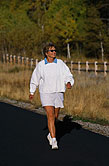- FDA Approves New Antibiotic Against UTIs
- New School Lunch Rules Target Added Sugars, Salt
- Dairy Cows Moved Across State Lines Must Now Be Tested for Bird Flu
- TikTok Riddled With Misleading Info on Health: Study
- Emulsifier Chemicals Are Everywhere in Foods. Could They Raise Diabetes Risk?
- Opioids During Pregnancy May Not Raise Psychiatric Risks for Offspring
- Could Heartburn Meds Raise Your Migraine Risk?
- Drug, Alcohol Abuse Goes Untreated in Many Ex-Prisoners
- Watchdog Group Says U.S. Food Recalls Rose Again Last Year
- Genes Could Mix With Pesticide Exposure to Raise Parkinson’s Risk
Moderate Exercise May Cut Women’s Stroke Risk


Brisk walking, tennis and other types of moderate exercise may lower a woman’s stroke risk by one-fifth, a new study says.
Being more active also offset the increased stroke risk linked with using hormone replacement therapy to treat the symptoms of menopause, the study found.
The researchers looked at the number of strokes that occurred among nearly 133,500 women in the California Teachers Study, which ran from 1996 to 2010.
Women who said they did moderate physical activity in the three years before enrolling in the study were 20 percent less likely to have a stroke than those who were inactive. The findings were to be presented Thursday at the American Stroke Association’s International Stroke Conference in San Diego.
“I was surprised that moderate physical activity was most strongly associated with a reduced risk of stroke,” study author Sophia Wang, a professor in the department of population sciences in the Beckman Research Institute at the City of Hope in Duarte, Calif., said in a stroke association news release.
“More strenuous activity, such as running, didn’t further reduce women’s stroke risk. Moderate activity, such as brisk walking, appeared to be ideal in this scenario,” she added.
The researchers also found that postmenopausal women taking hormone therapy were 30 percent more likely to have a stroke than those who never used hormone therapy, but moderate exercise helped reduce this increased risk. And after women stopped taking hormone therapy, their risk began to fall.
The findings show that women need to include physical activity into their daily routine, Wang said.
“You don’t have to do an extreme boot camp. The types of activities we’re talking about are accessible to most of the population,” and include power walking and recreational tennis, she noted.
While 87 percent of the women in the study were white, the results likely apply to women in other racial/ethnic groups, Wang added.
Research presented at medical meetings should be viewed as preliminary until published in a peer-reviewed journal.
And the study only found an association between exercise and reduced stroke risk. It did not prove cause-and-effect.
More information
The U.S. Centers for Disease Control and Prevention has more about stroke prevention.
Source: HealthDay
Copyright © 2024 HealthDay. All rights reserved.










